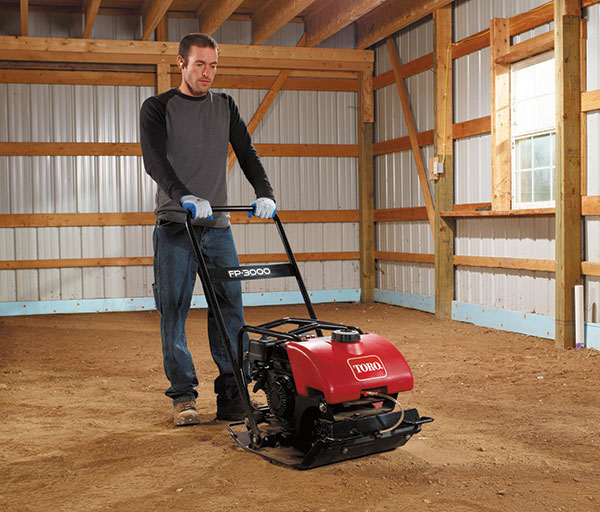Whether you operate a small, mid-size or large construction company, fleet management will keep you up at night. Most contractors practice due diligence in evaluating the numbers on large capital expenditures like wheel loaders and excavators. However, business owners often do not give that same level of consideration to acquiring more inexpensive equipment like vibratory plate compactors and rammers. If you fall into that category, you may want to rethink your approach.
The Basics on Light Compaction
Properly compacted soil is an important consideration on almost every construction job. Whether building a retaining wall or pouring concrete slabs or footings, establishing a solid foundation ensures structural longevity. From cracking concrete and leaky basement walls to underground pipes that break, many common infrastructural problems arise because the underlying soil is not solid or dense enough. Contractors who do not want to get called back a year after a project is completed should do everything possible to achieve the right amount of compaction before performing finishing work.
“There are a lot of variables to consider when looking at the right machine for the job,” says Anna Foster, marketing manager at Toro. “The place to start is reviewing the soil conditions. The amount of moisture and the granular size of the material will help determine the compaction force required and the size of machine needed to do the work effectively.”
The two main types of light compaction equipment are rammers and vibratory plate compactors. Rammers deliver high-amplitude blows at frequencies of 500 to 750 per minute to compact concessive soils. Vibratory plate compactors produce low-amplitude, high-frequency vibration best suited for compacting granular soils.
Two types of vibratory plate compactors are available. Forward plates travel only forward and are generally used for smaller areas and shallow lifts less than 12 inches. Reversible plates travel both forward and reverse and are heavier, which increases their compaction force.

Financial Considerations
“There are many factors that one should consider when looking at a rent-versus-buy decision,” says Tom Hubbell, vice president of marketing and communications for the American Rental Association. “First, contractors need to consider the cost of ownership of a given piece of equipment. In addition to the initial cash outlay to buy or finance a piece of equipment, cost of ownership also includes general operating costs like maintenance, repairs and storage.” Most of these costs increase over time and can have a significant effect on a contractor’s bottom line in the short and long terms.
“Next, contractors need to estimate the rate of utilization,” adds Hubbell. “This can be done by looking at the past year’s seasonal contracts, forecasted projects and potential prospects. Anything less than 60- to 70-percent utilization should be looked at carefully, since the profits made may not outweigh the cost of ownership. In those situations, contractors would be better served to rent rather than purchase a machine.”
Utilization Considerations
Most jobs don’t require a piece of compaction equipment to be operating for eight hours each day, five days a week. Compaction work tends to be the final step before a pad or a wall is poured, which means compaction equipment spends a lot of time sitting idle on the job or in the back of a truck. Idle equipment doesn’t make money. Even worse, since these units are typically found in the back of a truck when they aren’t working, they tend to have more exposure to wear and tear than larger equipment.
Maintenance Considerations
Compaction equipment is designed to apply force to the soil, but the machine absorbs just as much force. “Light compaction equipment is designed to take a lot of everyday job performance abuse,” says Foster. “Most manufacturers offer around a two-year warranty, but these units need to be properly maintained to ensure a long life expectancy. If a contractor isn’t staffed to do that, he is better off renting. Quality rental stores will have their mechanic check the machines out after every rental.”
The biggest service issue for light compaction equipment is the engine. “The majority of light compaction equipment is powered by small, gas-carbureted engines,” explains Foster. “When used often, these engines have great performance. However, carbureted engines tend to get gummed up when they haven’t been properly serviced or the appropriate steps aren’t taken when storing these machines for extended periods of time.”
Foster also points out that impure gasoline is a major cause of engine issues. “A lot of dust collects on the outside of those red five-gallon gas containers that contractors have in the back of their truck. It’s important to make sure the nozzles of those containers are clean when refueling.”
Adding It Up
If your organization specializes in concrete, asphalt or foundation work and the ground conditions tend to be the same from jobsite to jobsite, equipment ownership makes the most sense.
For everyone else, rental is your best option. Not only will you not have to worry about the routine maintenance and repair, you will likely have access to newer machines. Most rental houses have new compaction equipment in their fleets.
Selecting a Rental Partner
“Successful construction companies make it a priority to optimize their profitability by leveraging equipment rental,” says Hubbell. “In addition, they do a good job of finding the right rental partnership.”
Hubbell recommends searching for rental stores on ARA’s rentalhq.com. Enter the type of equipment you need and the location to get a list of local ARA-member rental companies that can meet your needs.
